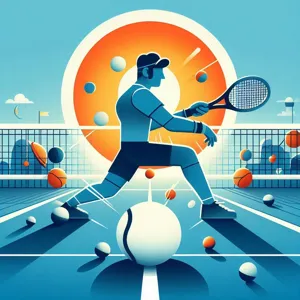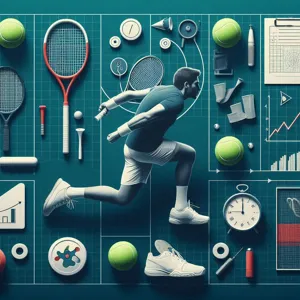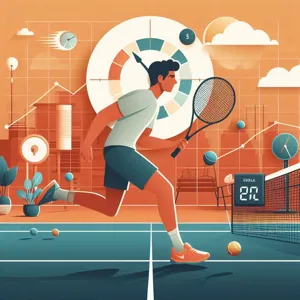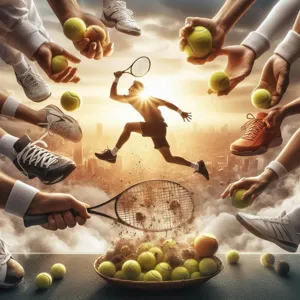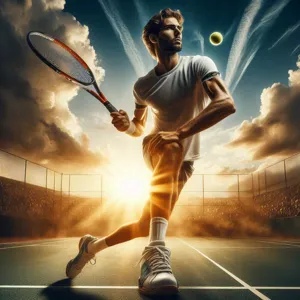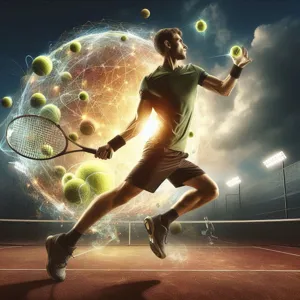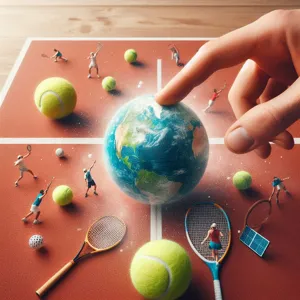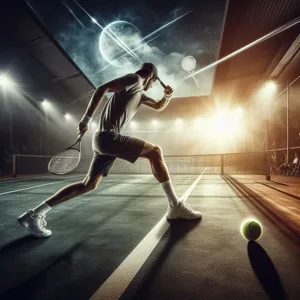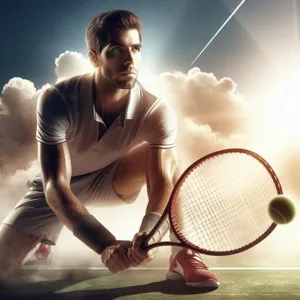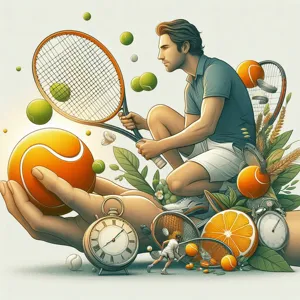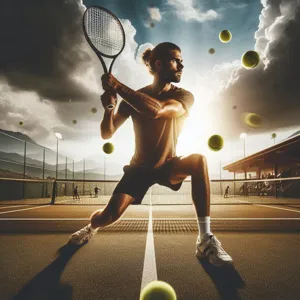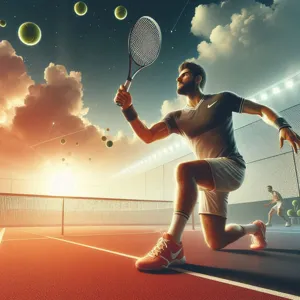Tennis is a game of agility, strategy, and finesse, offering both a challenging workout and an exhilarating way to socialize and unwind.
Whether you’re a seasoned player looking to sharpen your skills or a newcomer eager to learn the ropes, there’s always room for improvement on the court. In this blog post, we’ll explore a collection of dynamic tips designed to enhance your tennis skills while ensuring that every session remains enjoyable and engaging. From mastering your serve to perfecting your footwork, we’ll delve into techniques that not only elevate your game but also infuse each practice with excitement and camaraderie. So grab your racket, invite your friends, and get ready to discover how to master the court in a way that keeps the spirit of fun alive!
1. Understanding the Basics: Essential Tennis Techniques

Before you can serve like a pro or rally with finesse, it’s essential to grasp the fundamental techniques that form the backbone of your game. Understanding the basics of tennis isn’t just about learning the right grip or perfecting your stance—it’s about building a solid foundation that will support your growth and enjoyment on the court.
Start with your grip. The way you hold the racket can significantly impact your shots. The three most common grips—Eastern, Western, and Continental—each have their unique advantages. Experimenting with these grips will help you discover which one feels most comfortable and allows for better control over your shots. A proper grip can enhance your ability to generate spin and power, making your gameplay more dynamic.
Next, pay attention to your footwork. Tennis is as much a game of movement as it is of technique. Good footwork not only helps you reach the ball more efficiently but also allows you to position yourself for an optimal shot. Focus on shuffling, side-stepping, and pivoting; these movements will help you stay agile and ready to respond to your opponent’s plays.
Additionally, mastering the basic strokes—forehand, backhand, serve, and volley—is crucial. Begin with simple drills that emphasize form and consistency rather than power. Once you feel comfortable with your strokes, you can gradually incorporate more challenging elements, such as adding spin or varying your shot placement. Remember, repetition is key; the more you practice, the more natural these techniques will become.
Lastly, don’t underestimate the importance of mental preparation. developing a positive mindset can enhance your focus and resilience on the court. Visualize successful plays and set achievable goals for each practice session. This mental approach not only boosts your confidence but also makes your time on the court more enjoyable.
By solidifying these essential techniques, you’ll unlock a greater appreciation for the game, making each match a delightful blend of skill and fun. Whether you’re playing competitively or just for leisure, mastering the basics will provide a fulfilling foundation for your tennis journey.
2. Setting Goals: Defining Your Tennis Improvement Journey
Setting goals is a crucial step in defining your tennis improvement journey. Without a clear direction, it’s easy to lose motivation or become overwhelmed by the countless skills you could work on. Start by reflecting on your current abilities and identifying specific areas for improvement, whether that’s enhancing your serve, mastering your backhand, or improving your footwork.
Once you have pinpointed your focus areas, it’s essential to set SMART goals—Specific, Measurable, Achievable, Relevant, and Time-bound. For instance, rather than vaguely aiming to “get better at serving,” you could set a goal to “increase my first-serve percentage to 70% within the next month.” This not only provides you with a clear target but also a timeline to keep you accountable.
To make your journey even more enjoyable, consider setting both short-term and long-term goals. Short-term goals might include attending a certain number of practice sessions each week or successfully executing a new technique in your next match. Long-term goals could involve competing in a local tournament or achieving a particular ranking within your club.
Incorporating milestones into your goals can also add an element of fun; for example, reward yourself with a new piece of gear or a special treat after reaching a target. Regularly reassessing your goals will help you stay engaged and adapt your focus as your skills develop. Remember, the key to mastering tennis is not just hard work—it’s about enjoying the process and celebrating your achievements along the way. By setting thoughtful, actionable goals, you’ll not only enhance your skills but also deepen your love for the game.
3. The Importance of a Strong Warm-Up Routine

A strong warm-up routine is crucial not only for enhancing your tennis skills but also for ensuring that your time on the court remains enjoyable and injury-free. Imagine stepping onto the court feeling loose, energized, and ready to unleash your best performance—that’s the power of a well-structured warm-up.
Before you even pick up your racket, start with some dynamic stretches to get your blood flowing. Think of movements like arm circles, leg swings, and torso twists. These exercises not only help increase your heart rate but also prepare your muscles and joints for the quick, explosive movements that tennis demands. As you stretch, focus on the specific areas used in tennis: your shoulders, hips, and legs. This targeted approach helps improve your range of motion and flexibility, setting the stage for better shots and quicker footwork.
Next, incorporate some light footwork drills. Simple exercises like side shuffles, quick sprints, or even a few practice slides can work wonders in activating your muscles and sharpening your reflexes. As you engage in these movements, visualize the different angles and positions you’ll encounter during a match. This mental preparation is just as important as the physical aspect, allowing you to approach your practice or game with confidence.
Finally, finish your warm-up with some gentle rallies. Starting with slow, controlled shots helps you to find your rhythm and groove before ramping up the intensity. Use this time to focus on your technique—work on your grip, foot placement, and follow-through. Not only does this refine your skills, but it also fosters a sense of camaraderie with your partner, making your time on the court feel more like fun and less like a chore.
Incorporating a strong warm-up routine into your tennis practice can significantly enhance your performance while minimizing the risk of injury. So, take those extra minutes at the beginning of your session to warm up properly. Your body—and your game—will thank you!
4. Fun Drills to Improve Your Footwork
Mastering your footwork on the tennis court is crucial for enhancing your overall game, and incorporating fun drills into your practice can make the process enjoyable. Here are some engaging exercises that not only sharpen your agility but also add an element of playfulness to your training routine.
**1. Cone Sprint:** Set up a series of cones in a zigzag pattern on the court. Start at one end and sprint to each cone, focusing on quick foot movements and sharp direction changes. To make it more exciting, time yourself and challenge a partner to beat your best time. This drill enhances lateral movement while instilling a competitive spirit.
**2. Shadow Tennis:** Pair up with a friend and play a game of shadow tennis. Without a ball, mimic the movements you would make during a real match, focusing on your footwork as you follow your partner’s imaginary shots. This drill not only hones your footwork but also improves your anticipation skills, all while sharing a laugh over your exaggerated swings and playful antics.
**3. Ladder Drills:** Utilizing an agility ladder can be a fantastic way to boost your foot speed and coordination. Create patterns such as side shuffles, in-and-out jumps, or single-leg hops. To keep things light-hearted, add a music playlist that encourages spontaneous dance moves in between drills. This will help you stay engaged and entertained while focusing on your footwork.
**4. Tennis Tag:** Turn your footwork practice into a game of tag. Designate one player as “it,” and the goal is to tag your opponent while maintaining a tennis-ready stance. This drill emphasizes quick starts and stops, lateral movements, and the need to stay light on your feet. The element of fun will make you forget you’re even working on your footwork!
**5. Ball Toss Challenge:** With a partner, stand facing each other and toss a ball back and forth while you move side to side along the baseline. The objective is to catch the ball while maintaining proper foot positioning and balance. To add a twist, try tossing the ball with your non-dominant hand or vary the speed and height of your throws. This drill not only improves your footwork but also sharpens your hand-eye coordination.
By infusing your footwork drills with fun elements, you’ll enhance your skills while enjoying the process. Remember, the more you enjoy your practice, the more motivated you’ll be to improve, making your time on the court both productive and exhilarating!
5. Mastering Your Serve: Tips and Variations

Mastering your serve is one of the most crucial aspects of tennis, and it can also be one of the most enjoyable! A strong serve sets the tone for the point, allowing you to dictate play right from the start. To elevate your game and keep things exciting, let’s explore some essential tips and variations that will not only improve your serve but also inject a little fun into your practice sessions.
First and foremost, focus on your grip and stance. A proper grip is the foundation of an effective serve. The continental grip is commonly recommended for serving, as it allows for a wide range of spin and control. Experiment with your stance, too—whether you prefer a pinpoint or platform stance, find what feels comfortable and gives you the best balance.
Next, let’s dive into the mechanics of your serve. Start by perfecting your toss; it should be high enough to give you time to generate power but not so high that it throws off your timing. A consistent toss will lead to a more reliable serve. As you practice, pay attention to your follow-through. A complete, fluid motion not only adds power but also helps with accuracy.
Now, let’s explore the exciting variations of your serve. The flat serve is a powerful option that can be a real ace if executed correctly. Aim for the service box corner, and don’t be afraid to unleash your strength! On the other hand, the slice serve can create an unpredictable angle, pulling your opponent off the court. This variation is especially effective on grass or hard courts, where it can leave opponents scrambling.
For a fun twist, try integrating a kick serve into your practice. This serve adds an element of spin that can catch your opponent off guard. The key to a successful kick serve is to brush up on the ball during contact, creating that desirable upward spin. It’s not only effective but also a crowd-pleaser when executed well!
Lastly, practice makes perfect, and what better way to stay engaged than through games and drills? Organize serve competitions with friends, where you can keep score based on accuracy and variations. Incorporating fun challenges will not only enhance your skills but also foster camaraderie on the court.
By mastering your serve and experimenting with different techniques, you’ll not only become a formidable opponent but also have a blast while doing it. Embrace the challenge, keep your practice sessions lively, and enjoy the journey of improving your tennis serve!
6. Enhancing Your Groundstrokes: Backhand and Forehand Techniques
Mastering your groundstrokes is essential for any tennis player looking to elevate their game, and it’s one of the most rewarding aspects of the sport. Both the backhand and forehand strokes are vital components that can turn the tide of a match and make your time on the court even more enjoyable. Here are some techniques to enhance your groundstrokes while ensuring that you have fun on the court.
**Forehand Fundamentals**
The forehand is often considered the most powerful stroke in tennis, and perfecting it can significantly boost your performance. Start by positioning yourself correctly, with your non-dominant hand pointing towards the net and your feet shoulder-width apart. As the ball approaches, pivot your body and rotate your hips to generate power. Focus on making contact with the ball out in front of your body to allow for greater control and spin. Don’t forget to follow through with your swing; this not only adds power but also helps you prepare for your next shot. To keep things engaging, try experimenting with different grips—like the semi-western grip—for a variety of spins and angles.
**Backhand Brilliance**
While many players find the backhand challenging, it can be equally powerful when executed correctly. Whether you prefer a one-handed or two-handed backhand, the key lies in your stance and timing. For a two-handed backhand, keep your knees slightly bent and your weight on your back foot. As you swing, transfer your weight forward while using both hands to drive through the shot. If you opt for a one-handed backhand, remember to extend your arm fully while keeping your eyes locked on the ball. Practice hitting cross-court shots to improve your accuracy and maneuvering on the court. To make practice sessions more enjoyable, consider setting up mini-challenges or drills with friends—perhaps see who can hit the most consecutive backhands over the net!
**Incorporating Fun Drills**
To keep your practice engaging, incorporate drills that challenge both your skills and your creativity. Try practicing groundstrokes with a partner, where you alternate hitting forehands and backhands while aiming for specific targets on the court. You can also set up a fun game of “King of the Court,” where players rotate after losing a point, allowing everyone to work on their groundstrokes in a competitive yet playful environment. Remember, the goal is to enjoy yourself while honing your skills—so don’t hesitate to mix in some lighthearted competition!
By focusing on enhancing your groundstrokes with these techniques and fun drills, you’ll not only improve your tennis skills but also create lasting memories on the court. Whether you’re rallying with friends or competing in a match, mastering your backhand and forehand will leave you feeling more confident and ready to take on any challenge that comes your way. So grab your racket, hit the court, and let the fun begin!
7. The Power of Playing Doubles: Teamwork and Strategy

When it comes to enhancing your tennis skills, embracing the dynamics of doubles play can be a game-changer. Playing doubles isn’t just about sharing the court with a partner; it’s a vibrant dance of teamwork, strategy, and social interaction that can elevate your game to new heights. In singles, your focus is primarily on your own performance, but in doubles, you quickly learn that success hinges on collaboration.
The beauty of doubles lies in the synergy between teammates. Communication becomes paramount; you’ll need to develop a shorthand of signals and calls that help you anticipate each other’s moves. This not only fosters a deeper connection with your partner but also sharpens your awareness of court positioning and shot selection. Imagine the thrill of executing a perfectly timed volley or a strategic poach, all while knowing your partner is right there to support you.
Moreover, playing doubles cultivates your strategic thinking. It requires you to analyze your opponents’ strengths and weaknesses quickly, devising tactics that leverage your team’s skills. Should you play aggressive at the net or rely on baseline rallies? How do you exploit gaps in your opponents’ formation? These decisions enhance your critical thinking and adaptability, skills that will translate directly to your singles game.
And let’s not forget the social aspect of doubles. The camaraderie fostered on the court can make your practice sessions feel less like work and more like fun. Whether you’re laughing off a missed shot or celebrating a great rally, the positive energy of doubles play transforms the experience into a joyous one.
So, grab a friend, join a local doubles league, or simply invite fellow tennis enthusiasts to hit the courts. Not only will you improve your skills and strategy, but you’ll also foster friendships and create unforgettable memories—all while mastering the game you love.
8. Incorporating Games and Challenges into Practice
Incorporating games and challenges into your practice sessions is an excellent way to enhance your tennis skills while keeping the experience enjoyable and engaging. Tennis, while a serious sport, thrives on the thrill of competition and the joy of play. By introducing fun activities into your routine, you can break the monotony of traditional drills and foster a love for the game that will keep you coming back for more.
Start by organizing mini-tournaments with your friends or fellow players. This not only adds a competitive edge but also helps simulate real match conditions. Set up different courts for various skill levels and create brackets. Not only will you sharpen your skills, but you’ll also build camaraderie and create memories that make you look forward to practicing.
Another effective way to incorporate games is through skill-based challenges. For instance, set a target for the number of serves you need to land in a specific zone or challenge yourself to rally for a certain number of consecutive shots without missing. You can even create a point system for various drills, awarding points for successful volleys, serves, or groundstrokes. Compete against yourself or your friends to see who can accumulate the most points in a session, adding a layer of excitement and motivation to your practice.
Additionally, consider experimenting with unconventional games that encourage creativity and strategy. For example, play a match with only your non-dominant hand or use a larger ball to practice your footwork and reaction times. These variations not only enhance your skills but also keep your mind engaged and prevent burnout.
By weaving games and challenges into your practice, you transform routine drills into dynamic and enjoyable experiences. This approach not only fosters continuous improvement in your tennis skills but also nurtures a lifelong passion for the sport. Remember, tennis is meant to be fun – so embrace the playfulness and watch your game soar!
9. Mental Techniques for Staying Focused and Positive
Mastering the mental game is just as crucial as perfecting your serve or backhand. Tennis can be a rollercoaster of emotions, with highs of exhilarating victories and lows of frustrating defeats. To truly enhance your performance while keeping the experience enjoyable, incorporating mental techniques for staying focused and positive can make all the difference.
Start by practicing mindfulness during your matches. This involves staying present and fully engaged with each moment on the court. Instead of dwelling on a missed shot or a previous game, concentrate on your breathing and the feeling of your feet on the court. By anchoring your thoughts in the present, you can maintain clarity and reduce anxiety, allowing your natural skills to shine.
Visualization is another powerful technique to enhance your mental game. Before stepping onto the court, take a moment to close your eyes and imagine yourself executing perfect shots, moving fluidly, and maintaining a positive attitude regardless of the score. This mental rehearsal can boost your confidence and prepare you for various match scenarios, fostering a sense of control and readiness.
Additionally, develop a positive affirmation routine. Creating short, uplifting phrases—like “I am focused, I am strong” or “I play with joy and determination”—can help reinforce a positive mindset. Repeat these affirmations before matches or during changeovers to realign your thoughts and keep negativity at bay.
Lastly, embrace the power of gratitude. After each practice or match, take a moment to reflect on what went well, no matter how small. Whether it was executing a particularly challenging shot or simply enjoying time spent with friends on the court, acknowledging these positives can foster a sense of fulfillment and motivation to continue improving.
By integrating these mental techniques into your tennis practice, you’ll not only enhance your skills but also ensure that every moment on the court is enjoyable. Remember, tennis is as much about the joy of the game as it is about competition—keeping a positive mindset will help you master both.
10. Learning from the Pros: Analyzing Matches and Techniques
One of the most effective ways to elevate your tennis game is to learn from the professionals who have perfected their craft on the court. Watching matches, whether live or through video, provides a wealth of knowledge that can significantly enhance your skills while keeping the experience enjoyable. When you analyze the matches of top players, pay attention not just to the score but to their techniques, strategies, and mental approaches.
Start by choosing a player whose style resonates with you—be it the powerful serves of Serena Williams or the intricate footwork of Novak Djokovic. As you watch, take note of their shot selection, how they position themselves for each stroke, and their ability to anticipate their opponent’s moves. Look for patterns in their gameplay: how do they construct points, and what strategies do they employ against different types of opponents?
Beyond just observing, consider breaking down specific techniques. For instance, focus on their serve mechanics—watch how they grip the racquet, their toss, and their follow-through. Try to emulate these techniques during practice sessions, incorporating drills that mimic these professional moves.
Additionally, don’t shy away from utilizing available resources such as match analysis videos or coaching clinics that dissect professional games. Many platforms offer in-depth breakdowns of key matches, emphasizing pivotal moments and tactical decisions. Engaging with these resources can deepen your understanding of the game and inspire new strategies to incorporate into your play.
Finally, remember that learning from the pros is not just about replicating their techniques but also about adopting their mindset. Observe their mental resilience, focus, and sportsmanship. By combining these insights with your own practice, you’ll not only improve your game but also keep the joy of tennis alive as you uncover the nuances of this captivating sport. So grab your racquet, hit the court, and embrace the thrill of learning from the best!
11. The Role of Fitness and Conditioning in Tennis
Fitness and conditioning play a pivotal role in elevating your tennis game while ensuring you have a blast on the court. Unlike many other sports, tennis demands not just skill but also stamina, agility, and strength. Picture this: you’re engaged in a long rally, your opponent is hitting relentless groundstrokes, and you find yourself running side to side, chasing down every ball. It’s in these moments that a well-conditioned body can make all the difference.
To truly master the court, it’s essential to develop a comprehensive fitness routine that complements your tennis practice. Focus on building endurance through aerobic exercises such as running, cycling, or swimming. These activities will enhance your stamina, allowing you to maintain your performance even in the longest of matches. Incorporate interval training to mimic the bursts of energy required during games—a series of fast-paced rallies followed by short recovery periods can prepare you for the unpredictable pace of a match.
Agility is another key component of tennis fitness. conduct drills that improve your footwork, such as ladder exercises or cone drills, which will not only enhance your quickness but also your ability to change directions seamlessly. Strength training—targeting your core, legs, and arms—will also provide the necessary power for your serves and groundstrokes. Resistance exercises, such as squats, lunges, and medicine ball throws, can help you build the explosive strength needed to outmaneuver your opponents.
But remember, fitness doesn’t have to be a chore! Incorporate fun into your conditioning routine. Join a tennis-based fitness class or engage in friendly competition with friends. Play games that involve agility training, like tag or shuttle runs, to keep the atmosphere light-hearted. The key is to make fitness enjoyable so that it seamlessly integrates into your love for tennis.
Ultimately, a fit body not only enhances your performance but also enriches your overall tennis experience. When you’re feeling strong and agile, you can focus on strategy and skill, allowing you to enjoy the game even more. So, lace up those sneakers, hit the court, and let the joy of movement fuel your tennis journey!
12. Finding the Right Equipment: Rackets, Strings, and Shoes
When it comes to enhancing your tennis skills, having the right equipment can make all the difference. The journey to mastering the court begins with selecting a racket that feels like an extension of your arm. Whether you’re a beginner or a seasoned player, the racket’s weight, grip size, and head type can significantly impact your game. For novices, a lightweight racket with a larger head is ideal for generating power and forgiveness on off-center hits. As you progress, you might seek a more specialized racket tailored to your playing style, be it control, spin, or power.
Equally important are the strings that weave through your racket. The tension and type of string can affect everything from ball feel to spin potential. A lower tension can offer more power and comfort, while higher tension can enhance control and precision. Experimenting with different strings can help you find the right balance that complements your style and enhances your performance on the court.
And let’s not forget about footwear—one of the most critical aspects of your tennis gear. A good pair of tennis shoes provides the necessary support and traction to help you move swiftly and confidently across the court. Look for shoes that are specifically designed for tennis, as they offer stability and cushioning tailored to the sport’s lateral movements. Whether you prefer clay, hard courts, or grass, investing in the right shoes can help prevent injuries and improve your overall game.
Ultimately, the key to enjoying tennis and improving your skills lies in finding the perfect blend of equipment that resonates with your playing style and enhances your comfort. Take the time to research and test different options, and don’t be afraid to seek advice from fellow players or professionals at your local sports store. With the right racket, strings, and shoes, you’ll be well on your way to mastering the court while having a blast!
13. Building a Supportive Tennis Community
Building a supportive tennis community is like crafting your very own winning doubles team—where every player uplifts one another, shares insights, and celebrates each other’s successes. The connection you form with fellow players can greatly enhance your experience on the court, making your journey toward improvement not only effective but enjoyable as well.
Start by joining local clubs or teams where you can meet players of varying skill levels. Engage in friendly matches, and don’t hesitate to strike up conversations during break times or at social events. Sharing tips, techniques, and even personal stories creates a bond that goes beyond just the game. Consider organizing regular practice sessions or drills where you can learn from each other, honing your skills while also fostering camaraderie.
Social media can also be a powerful tool for building your tennis community. Create or join groups dedicated to local tennis enthusiasts. Use these platforms to share achievements, seek advice, and coordinate meet-ups. Online forums can be an excellent place for discussing strategies, equipment, and even fitness routines that complement your on-court performance.
Moreover, attending local tournaments as a spectator is a great way to connect with the tennis community. You’ll not only gain inspiration from watching skilled players but also meet like-minded individuals who share your passion for the sport. These connections can lead to valuable friendships and even potential practice partners.
Ultimately, a supportive tennis community encourages growth and fosters a love for the game. By surrounding yourself with enthusiastic players, you’ll find motivation in the collective energy, helping you improve your skills while having fun. Whether it’s through local clubs, social media, or community events, investing time into building these relationships will enrich your tennis journey and enhance your overall experience on the court.
14. Balancing Competition and Enjoyment on the Court
Balancing competition and enjoyment on the court is crucial for any tennis player, whether you’re a seasoned veteran or just picking up a racket for the first time. The thrill of competition can be intoxicating, but it’s essential to remember that tennis is fundamentally a game—a pursuit meant to be enjoyed. Here are some tips to help you strike that perfect balance.
Start by setting personal goals that focus on both improvement and enjoyment. Instead of fixating solely on winning matches, aim to develop specific skills, like perfecting your serve or mastering your footwork. Celebrate your progress in these areas, no matter how small, as this will keep your motivation high and your mindset positive.
When playing with others, choose partners who share a similar outlook. Look for players who prioritize fun as much as competition. This could mean mixing up your usual playing partners with friends who are just starting out or engaging in lighthearted matches where the score is secondary to the experience. Playing with a variety of skill levels can introduce new dynamics and help you appreciate the game from different perspectives.
Incorporate games and drills that foster a sense of playfulness. Instead of standard rallies, try fun challenges, like who can hit the most consecutive shots without missing or experimenting with unconventional strokes. These activities not only improve your skills but also infuse your practice sessions with laughter and camaraderie, keeping the atmosphere light and enjoyable.
Lastly, always remind yourself of the reasons you love the game. Whether it’s the thrill of hitting a perfect shot, the exhilaration of a close match, or simply the joy of being outdoors, focusing on these aspects will help you maintain a healthy balance between competition and enjoyment. By keeping the fun in your game, you’ll not only enhance your skills but also foster a lifelong love for tennis that will keep you coming back to the court for years to come.
15. Celebrating Progress: Keeping the Fun in Your Tennis Journey
In the world of tennis, where competition can sometimes overshadow the joy of the game, it’s essential to celebrate your progress and keep the fun alive. As you navigate your tennis journey, remember that improvement doesn’t always have to be about winning matches or perfecting your serve. Instead, focus on the small victories that contribute to your overall growth as a player.
Each time you master a new shot, improve your footwork, or even just enjoy a spirited rally with friends, take a moment to acknowledge your achievements. Consider keeping a journal to document these milestones, no matter how minor they may seem. Reflecting on your progress can boost your motivation and remind you of how far you’ve come, even on days when the score doesn’t reflect your hard work.
Incorporating fun into your practice routines is another fantastic way to maintain enthusiasm for the game. Organize friendly matches with peers, engage in fun drills, or even try out unconventional games like “King of the Court” to keep your training lively and enjoyable. Don’t forget to celebrate not just your own progress, but also that of your friends and teammates. Share in their successes, offer encouragement, and create a supportive community that thrives on collective improvement.
Finally, reward yourself for reaching your goals—whether it’s treating yourself to new gear, enjoying a special meal, or simply taking a day off to relax and recharge. By celebrating your progress and keeping the spirit of fun at the forefront of your tennis journey, you’ll not only enhance your skills but also foster a lifelong love for the game. After all, tennis is more than just a sport; it’s an adventure filled with friendship, laughter, and unforgettable memories.
As we wrap up our exploration of how to enhance your tennis skills while keeping the game enjoyable, remember that the essence of tennis lies not just in mastering techniques but also in the joy of play. By incorporating the tips discussed, from refining your serve to embracing the power of teamwork, you can elevate your game and foster a love for the sport that transcends competitiveness. Whether you’re practicing with friends, participating in friendly matches, or enjoying solo drills, let the thrill of tennis invigorate your spirit and keep you coming back for more. So grab your racket, hit the courts, and play your heart out—every match is an opportunity to learn, grow, and most importantly, have fun!

